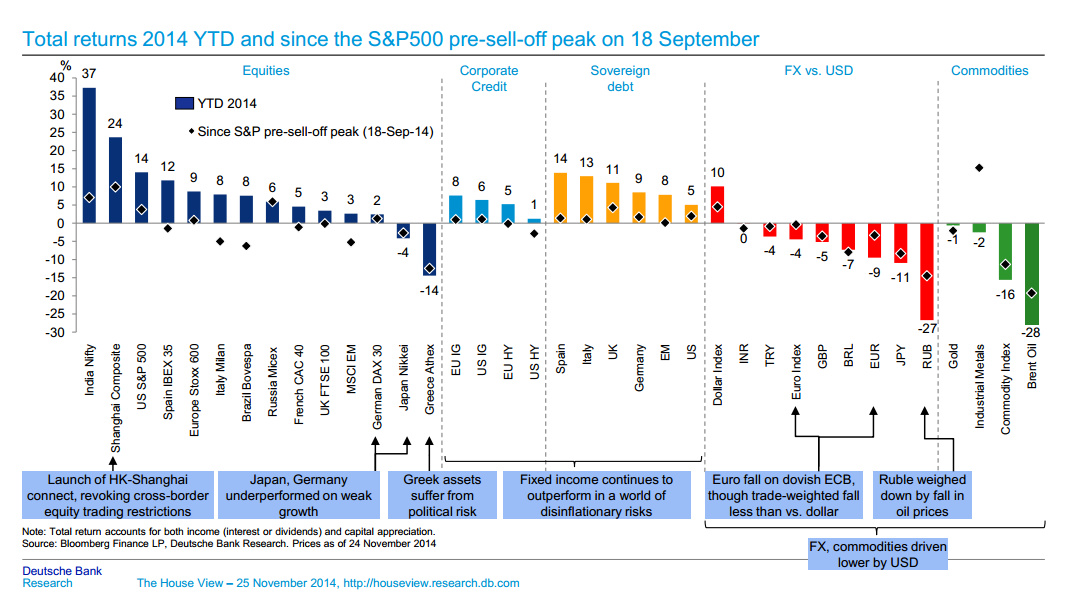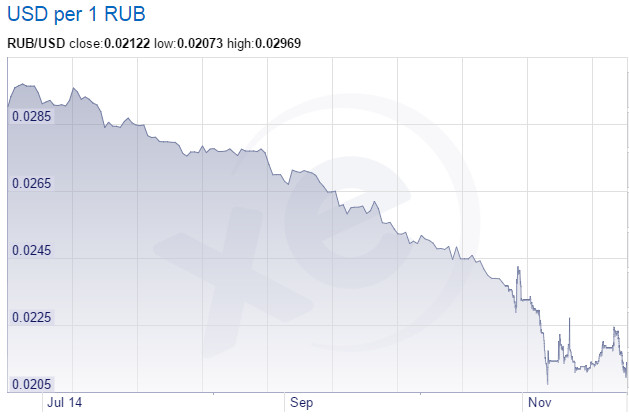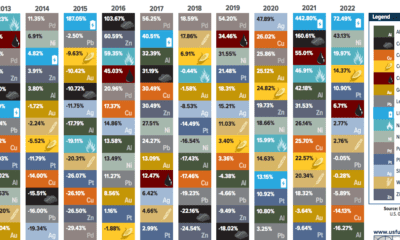The Returns of Every Asset Class So Far in 2014
This all encompassing chart, straight from Deutsche Bank, summarizes the YTD returns up to this week with all major asset classes including stocks, government and corporate bonds, currency markets, gold, and commodities. From our perspective, there are a few things worth noting. Firstly, despite the bearish undertones of the market from those investing in precious metals, gold is actually flat on the year. The current sentiment is not really warranted based on actual performance, so this could be an overshoot of negativity that doesn’t reflect market realities. In other words, this could be yet another sign of the bottom. Next, the chart really shows some of the stories of the year. The USD strength rings loud and clear with all foreign currencies and commodities uniformly dropping. However, nothing has dropped as much as the Russian ruble which is the worst performing asset class of the year.
The strength of the ruble is highly correlated to the price of Brent oil, which is the other poorest performer YTD (-28%). This will continue to be a problem for Putin’s Russia as the breakeven price for Russia’s national budget depends on $102/bbl Brent. With today’s added oil plunge as OPEC producers meet, this will not be remedied anytime soon. The last note is that the chart also shows returns since the S&P 500 pullback that occurred in September. While most assets are down or flat since that event, the notable exceptions are Indian and Chinese equities, along with industrial metals.
Recommended Posts
Gold: The Most Sought After Metal on Earth A Year’s Worth of Resources in BCA Crude Problem For Putin’s Russia on Last year, stock and bond returns tumbled after the Federal Reserve hiked interest rates at the fastest speed in 40 years. It was the first time in decades that both asset classes posted negative annual investment returns in tandem. Over four decades, this has happened 2.4% of the time across any 12-month rolling period. To look at how various stock and bond asset allocations have performed over history—and their broader correlations—the above graphic charts their best, worst, and average returns, using data from Vanguard.
How Has Asset Allocation Impacted Returns?
Based on data between 1926 and 2019, the table below looks at the spectrum of market returns of different asset allocations:
We can see that a portfolio made entirely of stocks returned 10.3% on average, the highest across all asset allocations. Of course, this came with wider return variance, hitting an annual low of -43% and a high of 54%.
A traditional 60/40 portfolio—which has lost its luster in recent years as low interest rates have led to lower bond returns—saw an average historical return of 8.8%. As interest rates have climbed in recent years, this may widen its appeal once again as bond returns may rise.
Meanwhile, a 100% bond portfolio averaged 5.3% in annual returns over the period. Bonds typically serve as a hedge against portfolio losses thanks to their typically negative historical correlation to stocks.
A Closer Look at Historical Correlations
To understand how 2022 was an outlier in terms of asset correlations we can look at the graphic below:
The last time stocks and bonds moved together in a negative direction was in 1969. At the time, inflation was accelerating and the Fed was hiking interest rates to cool rising costs. In fact, historically, when inflation surges, stocks and bonds have often moved in similar directions. Underscoring this divergence is real interest rate volatility. When real interest rates are a driving force in the market, as we have seen in the last year, it hurts both stock and bond returns. This is because higher interest rates can reduce the future cash flows of these investments. Adding another layer is the level of risk appetite among investors. When the economic outlook is uncertain and interest rate volatility is high, investors are more likely to take risk off their portfolios and demand higher returns for taking on higher risk. This can push down equity and bond prices. On the other hand, if the economic outlook is positive, investors may be willing to take on more risk, in turn potentially boosting equity prices.
Current Investment Returns in Context
Today, financial markets are seeing sharp swings as the ripple effects of higher interest rates are sinking in. For investors, historical data provides insight on long-term asset allocation trends. Over the last century, cycles of high interest rates have come and gone. Both equity and bond investment returns have been resilient for investors who stay the course.


















